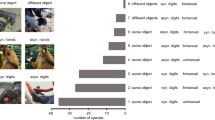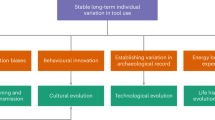Abstract
One of the two major theories regarding the evolution of intelligence in primates is that feeding strategies determine mental development. Evidence for this theory is reviewed and related to extractive foraging, which is the act of locating and/or processing embedded foods such as underground roots and insects or hard-shelled nuts and fruits. It is shown that, although only cebus monkeys and chimpanzees in the wild use tools in extractive foraging, many other species of mammals (including primates) and birds are capable of extracting embedded foods without tools. Extractive foraging by primates is compared to extractive foraging by other mammals and birds to assess whether: 1) extractive foraging involves cognition, and 2) extractive foraging by primates is unique in a way that may mean it played a role in the development of intelligence among primates. This comparison reveals that some acts of extractive foraging by nonprimates are equally sophisticated as those of primates. It is suggested that extractive foraging played no significant role in the evolution of primate intelligence. Hypotheses for testing precise differences in extractive foraging ability across taxa are offered, and the roles of olfactory cues, manual dexterity, and strength in extractive foraging are evaluated.
In conclusion, the hominization process is briefly reviewed in relation to foraging behavior. A «package» of traits that, in combination, is unique to hominids is discussed: tool-aided extractive foraging, division of labor by sex with food exchange, and feeding of juveniles.
Similar content being viewed by others
References
Alexander R.D. (1979). Darwinism and Human Affairs. Seattle: University of Washington Press.
Altmann S.A. (in press). Foraging and Nutrition in Weanling Baboons. Chicago: University of Chicago Press.
Altmann S.A. &Altmann J. (1970). Baboon Ecology: African Field Research. Chicago: University of Chicago Press.
Andrews P. (1981).Hominoid habitats of the Miocene. Nature, 289: 749.
Beck B.B. (1980). Animal Tool Behavior, New York: Garland Stpm Press.
Beck B.B. (1982).Chimpocentrism: Bias in cognitive ethology. Journal of Human Evolution 11: 3–17.
Bishop A. (1962).Control of the hand in lower primates. Annals of the New York Academy of Sciences, 102: 316–337.
Boesch C. &Boesch H. (1983).Optimisation of nut-cracking with natural hammers by wild chimpanzees. Behaviour, 83: 265–285.
Boesch C. &Boesch H (1984).Mental map in wild chimpanzees: an analysis of hammer transports for nut-cracking. Primates, 25: 160–170.
Bourliere F., Hunkeler C. &Bertrand M. (1970).Ecology and behavior of Lowe’s guenon (Cercopithecus campbelli lowei) in the Ivory Coast. In (J. R. Napier, P. Ha. Napier, Eds) Old World Monkeys, pp. 299–350. New York: Academic Press.
Campbell B.G. (1982). Humankind Emerging. Boston: Little, Brown.
Casimir M.J. (1975).Feeding ecology and nutrition of an eastern gorilla group in the Mt. Kahuzi region. Folia primatologica, 24: 81–136.
Charles-Dominique P. &Petter J.J. (1980).Ecology and social life of Phaner furcifer. In (P. Charles-Dominiqueet al., Eds) Nocturnal Malagasy Primates: Ecology Physiology, and Behavior, pp. 75–96. New York: Academic Press.
Clutton-Brock T.H. &Harvey P. (1980).Primates, brains and ecology. Journal of Zoology (London), 190: 309–323.
Cowie R.J., Krebs J.R. &Sherry D.F. (1981).Food storing by marsh tits. Animal Behaviour, 29: 1252–1259.
Crockett C.M. &Wilson W.L. (1980)The ecological separation of Macaca nemestrina and Macaca fascicularis in Sumatra. In (D. Lindburg, Ed) The Macaques, pp. 148–181. New York: Van Nostrand Reinhold.
Crook J.H. (1980). The Evolution of Human Consciousness. Oxford: Clarendon Press.
Crook J.H. &Aldrich-Blake P. (1968).Ecological and behavioral contrasts between sympatric ground dwelling primates in Ethiopia. Folia primatologica, 8: 192–227.
Dunbar R.I.M. (1977).Feeding ecology of gelada baboons: a preliminary report. In (T.H. Clutton-Brock, Ed) Primate Ecology, pp. 251–273. London: Academic Press.
Dunbar R.I.M. (1983).Theropithecines and hominids: contrasting solutions to the same ecological problem. Journal of Human Evolution, 12: 647–658.
Eisenberg J.F. &Wilson D. (1978).Relative brain size and feeding strategies in the Chiroptera. Evolution, 32: 740–751.
Ewer R.F. (1968). Ethology of Mammals. New York: Plenum Press.
Galdikas B.M.F. (1982).Orangutan tool use at Tanjung Puting Reserve, Central Indonesian Borneo (Kalimantan Tengah). Journal of Human Evolution, 11: 19–33.
Goodall J. (1964).Tool-using and aimed throwing in a community of free-living chimpanzees. Nature, 201: 1264–1266.
Hamilton W., Buskirk R. &Buskirk W. (1978).Environmental developmental determinants of object manipulation by chacma baboons in two southern African environments. Journal of Human Evolution, 7: 205–216.
Harrisson M. (1984).Optimal foraging strategies in the diet of the green monkey, Cercopithecus sabaeus, at Mt. Assirik, Senegal. International Journal of Primatology, 5: 435–471.
Hatley T. &Kappelman S. (1980).Bears, pigs and Plio-Pleistocene hominids: a case for the exploitation of belowground food resources. Human Ecology 8: 371–387.
Hernandez-Camacho J. &Cooper R.W. (1976).The non-human primates of Colombia. In (R.W. Thorington Jr. and P.G. Heltne Eds) Neotropical Primates: Field Studies and Conservation, pp. 35–69. Washington, D. C.: National Academy of Sciences.
Hill W.C.O. (1966).Primates. Vol. VI Cercopithecoidea. Edinburgh: Edinburgh University Press.
Hladik C.M. (1979).Diet and ecology of prosimians. In (G.A. Doyle and R.D. Martin, Eds) The Study of Prosimian Behavior, pp. 307–375. New York: Academic Press.
Humphrey N.K. (1976).The social function of intellect. In (P.P.G. Bateson and R.A. Hinde, Eds) Growing Points in Ethology, pp. 303–317. Cambridge: Cambridge University Press.
Isaac G. (1980).Casting the net wide: a review of archaeological evidence for early hominid land-use and ecological relations. In (L. Koniggson, Ed) Current Argument on Early Man. Oxford: Pergamon Press.
Johanson D.C. &Edey M. (1981). Lucy: The Beginnings of Humankind. New York: Simon and Schuster.
Johanson D.C. &White T.D. (1979).A systematic assessment of early African hominids. Science, 203: 321–329.
Jolly A. (1966).Lemur social intelligence and primate intelligence. Science 153: 501–506.
Jolly A. (1985). The Evolution of Primate Behavior. 2nd ed. New York: Macmillan Publishing Company.
Kay R.F. (1981).The nut-crackers: a nez theory of the adaptations of the Ramapithecinae. American Journal of Physical Anthropology, 55: 141–152.
Kinzey W.G. (1977).Diet and feeding behaviour of Callicebus torquatus. In (T.H. Clutton-Brock, Ed) Primate Ecology, pp. 127–159. London: Academic Press.
Kummer H. (1968). Social Organization of Hamadryas Baboons. Chicago: University of Chicago Press.
Kummer H. (1982).Social knowledge in free-ranging primates. In (D. Griffin, Ed) Animal Mind-Human Mind pp. 113–130. Berlin: Springer-Verlag.
Kurland J.A. &Beckerman S.J. (1985).Optimal foraging and hominid evolution: labor and reciprocity. American Anthropologist, 87: 73–93.
Lancaster J.B. &Lancaster C.S. (1983).Parental investment: the hominid adaptation. In (D. Ortner, Ed) How Humans Adapt: A Biocultural Odyssey, pp. 33–56. Washington, D. C.: Smithsonian Institution Press.
Lovejoy C.O. (1981).The origin of man. Science 211: 341–350.
Mace G.H., Harvey P.H. &Clutton-Brock T.H. (1981).Brain size and ecology in small mammals. Journal of Zoology (London) 193: 333–354.
McGrew W.C. (1979a).Evolutionary implications of sex differences in chimpanzee predation and tool use. In (D.A. Hamburg and E.R. McCown, Eds) The Great Apes, pp. 440–463. Menlo Park, California: Benjamin Cummings Publishing Company.
McGrew W.C. (1979b).Habitat and the adaptiveness of primate intelligence (reply to Parker and Gibson). Behavioral and Brain Sciences, 2: 393.
McGrew W.C. &Rogers M.R. (1983).Chimpanzees, tools, and termites: new record from Gabon. American Journal of Primatology 5 (2): 171–174.
McGrew W.C., Tutin C.E.G. &Baldwin P. (1979).Chimpanzees, tools, and termites: cross-cultural comparisons of Senegal, Tanzania and Rio Muni. Man (n.s.) 14: 185–214.
McGrew W.C. (1981).Social and cognitive capabilities of nonhuman primates: lessons from the wild to captivity. International Journal for the Study of Animal Problems 2: 138–149.
Menzel E.W. &Wyers E.J. (1981).Cognitive aspects of foraging behavior. In (A.C. Kamil and T.D. Sargent, Eds) Foraging Behavior. New York: Garland STPM Press.
Milton K. (1981).Distribution patterns of tropical plant foods as an evolutionary stimulus to primate mental development. American Anthropologist, 83: 534–548.
Milton K. (1984).The role of food-processing factors in primate food choice. In (P.S. Rodman and J.G.H. Cant, Eds) Adaptations for Foraging in Nonhuman Primates, pp. 249–279. New York: Columbia University Press.
Nishida T. &Hiraiwa M. (1982).Natural history of tool-using behavior by wild chimpanzees in feeding upon wood-boring ants. Journal of Human Evolution, 7: 597–608.
Parker S.T. &Gibson K.R. (1977).Object manipulation, tool use and sensorimotor intelligence as feeding adaptations in cebus monkeys and great apes. Journal of Human Evolution 6: 623–641.
Parker S.T. &Gibson K.R. (1979).A developmental model for the evolution of language and intelligence in early hominids. Behavioral and Brain Sciences 2: 367–408.
Pilbeam D. (1979).Recent finds and interpretations of Miocene hominoids. Annual Review of Anthropology, 8: 333–352.
Pilbeam D. (1980).Major trends in buman evolution. In (L. Koniggson. Ed) Current Argument on Early Man, pp. 261–285. Oxford: Pergamon Press.
Pirlot P. &Pottier J. (1977).Encephalization and quantitative brain composition in bats in relation to their life-habits. Review of Canadian Biology, 36: 321–336.
Rhine R.J. &Westlund B.J. (1978).The nature of a primary feeding habit in different age-sex classes of yellow baboons (Papio cynocephalus). Folia primatologica, 30: 64–79.
Richard A.F. (1985). Primates in Nature. New York: Freeman and Company.
Rijksen H.D. (1978). A Field Study on Sumatran Orangutans (Pongo pygmaeus abelii). Wageningen: H. Veenman and Zonen B.V.
Ripley S. (1970).The social organization of foraging in gray langurs (Presbytis entellus thersites). In (J.R. Napier and P.H. Napier, Eds) Old World Monkeys, pp. 481–509. New York: Academic Press.
Rodman P.S. &McHenry H.M. (1980).Bioenergetics and the origin of hominid bipedalism. American Journal of Physical Anthropology, 52: 103–106.
Sherry D.F., Krebs J.R. &Cowie R.J. (1981).Memory for the ___location of stored food in marsh tits. Animal Behaviour, 29: 1260–1266.
Sherry D.F. (1984).Food storage by black-capped chickadees: memory for the ___location and contents of caches. Animal Behaviour, 32: 451–464.
Simons E.L. (1977).Diversity among hominids: a vertebrate paleontologist’s viewpoint. In (C. Jolly, Ed) Early Hominids of Africa, pp. 543–566. New York: St. Martin’s Press.
Struhsaker T.T. (1978).Food habits of five monkey species in the kibale Forest, Uganda. In (D.J. Chivers and J. Herbert, Eds) Recent Advances in Primatology, pp. 225–248. New York: Academic Press.
Strunhsaker T.T. &Hunkeler P. (1971).Evidence of tool-using by chimpanzees on the Ivory Coast. Folia primatologica 15: 212–219.
Sugiyama Y. &Koman J. (1977).Tool-using and-making behavior in wild chimpanzees at Bossou, Guinea. Primates, 20: 513–524.
Sussman R.W. &Kinzey W.G. (1984).The ecological role of the Callitrichidae: a review. American Journal of Physical Anthropology. 64: 419–449.
Sussman R.W. &Tattersall I (1981).Behavior and ecology of Macaca fascicularis in Mauritius: a preliminary study. Primates, 22: 192–205.
Tanner N.M. (1980).On Becoming Human. Cambridge: Cambridge University Press.
Terborgh J. (1983). Five New World Primates: A Stydy in Comparative Ecology. Princeton: Princeton University Press.
Uehara S. (1982).Seasonal changes in the techniques employed by wild chimpanzees in the Mahale Mountains, Tanzania, to feed on termites (P. spiniger). Folia primatologica, 37: 44–76.
Vander Wall S.B. (1982).An experimental analysis of cache recovery in Clark’s nutcracker. Animal Behaviour, 30: 84–94.
Walker A. (1981).Diet and teeth: dietary hypotheses and human evolution. Philosophical Transactions of the Royal Society of London, B 292: 57–64.
Waser P. (1977).Feeding, ranging and group size in the mangabey Cercocebus albigena. In (T.H. Clutton-Brock, Ed) Primate Ecology, pp. 183–222. New York: Academic Press.
Welles J.F. (1975).The anthropoid hand: a comparative study of prehension. In Contemporary Primatology, pp. 30–33. 5th International Congress of Primatology. Basel: Karger.
Wolpoff M. (1982).Ramapithecus and hominid origins. Current Anthropology, 23: 5012–522.
Zilhman A.L. (1981).Women as shapers of the human adaptation. In (F. Dhlberg, Ed) Woman the Gatherer, pp. 75–120. New Haven: Yale University Press.
Author information
Authors and Affiliations
Rights and permissions
About this article
Cite this article
King, B.J. Extractive foraging and the evolution of primate intelligence. Hum. Evol. 1, 361–372 (1986). https://doi.org/10.1007/BF02436709
Received:
Accepted:
Issue Date:
DOI: https://doi.org/10.1007/BF02436709




